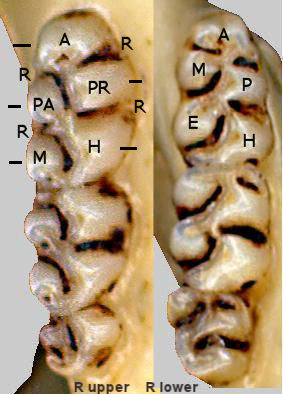Class Mammalia
Order Rodentia
Family Cricetidae
Subfamily Arvicolinae—Voles // Subfamily Neotominae—Neotomine Mice and Rats // Subfamily Sigmodontinae—Sigmodontine Mice and Rats
There seems to be no generally accepted common name for this large, diverse family. Though often called the New World mice and rats, the voles and some other groups are heavily invested in the Old World. Perhaps just Cricetid Rodents will have to serve.
Cricetid taxonomy has undergone (and probably will continue to undergo) repeated upheavals that result in considerable confusion when addressing the literature over a period of years. In the older tradition, the families Muridae (Old World Mice and Rats) and Cricetidae were separate, with the Cricetidae divided (for our region) into the subfamilies Cricetinae and Microtinae. Somewhat more recently, all were considered to fall within the Muridae, with our representatives divided among the subfamilies Murinae (Old World mice and rats, consisting of historically introduced species only), Sigmodontinae (mice and rats with generally non-prismatic teeth; not vole-like), and Arvicolinae (mice and rats with prismatic teeth; vole-like; equal to the earlier Microtinae). Most recently (Wilson and Reeder, 2005), the Muridae and Cricetidae have been recognized once more as separate families; however, the Cricetidae has been reorganized so that it now consists (within our region) of three subfamilies: those earlier recognized as sigmodontines have been split into two subfamilies, the Neotominae (woodrat and white-footed mouse types) and the Sigmodontinae (forms with southern affinities, such as cotton rats). The third subfamily remains the Arvicolinae (voles, sensu lato).
 Characteristics include a reduced dental
battery of formula 1/1 0/0 0/0 3/3 = 16 . The complexity of the cheek teeth varies
greatly, but the basic pattern from which more complex patterns have been derived is of
five crests separated by reentrants (Fig. 1). This pattern becomes obscured in the
Arvicolinae, which have prismatic
and often hypselodont
dentition.
Characteristics include a reduced dental
battery of formula 1/1 0/0 0/0 3/3 = 16 . The complexity of the cheek teeth varies
greatly, but the basic pattern from which more complex patterns have been derived is of
five crests separated by reentrants (Fig. 1). This pattern becomes obscured in the
Arvicolinae, which have prismatic
and often hypselodont
dentition.
The post-cranial skeleton is generalized, but with the distal tibia and fibula fused.
Fig. 1. Upper and lower tooth rows of Peromyscus showing crests (cusps) and reentrants ("R"). Short bars indicate the five crests. The overall aspect is typical of the "peromyscine" genera. A = Anterocone (upper), Anteroconid (lower); PR = protocone (upper), P = protoconid (lower); PA = Paracone; M = Metacone (upper), Metaconid (lower); H = Hypocone (upper), Hypoconid (lower); E = Entoconid.
Last Update: 7 Mar 2013